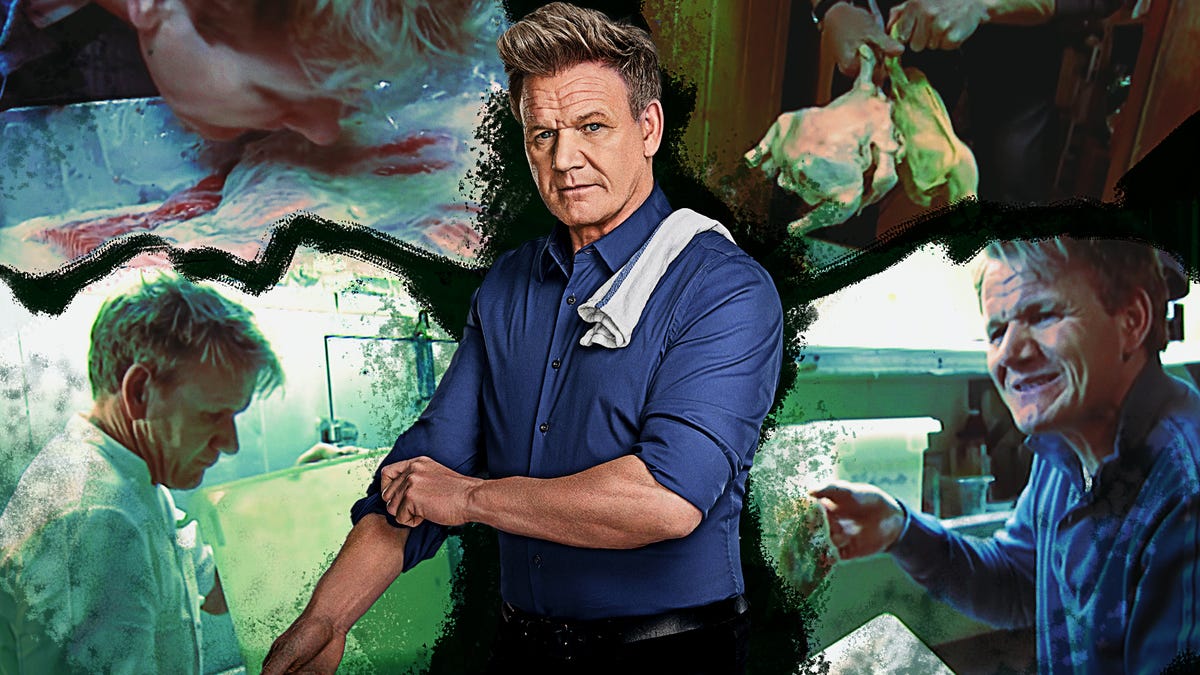
On December 27, 2004, Channel 4 viewers got their first taste of the latest offering from an ornery, furrow-browed chef and TV personality on the rise named Gordon Ramsay. Entering the “fine-dining” pub Bonapartes for lunch on a rain-slicked strip in Silden, England, Ramsay asked the proprietor how many she had served the night prior. “Two.” Today? “Two.” Then-not-yet an internationally known master chef and TV personality, whose only major appearances were in the documentary series Boiling Point and an episode on Anthony Bourdain’s No Reservations, Ramsay had a full plate, and then he saw the kitchen.
The “Bonapartes” episode of Ramsay’s Kitchen Nightmares is a perfect pilot. It cements the structure of the project—the U.S. version of the show that followed is titled, simply, Kitchen Nightmares—would follow for the next decade and, presumably, will follow when it returns to Fox on September 25 for the first time since 2014. Ramsay’s back ransacking kitchens, and we’re once again privy to those glorious moments when he opens the fridge to discover lentils that look like rabbit turds, a brown mass he likens to a “sheep’s turd that has been infested with ants,” and other foods so far past the sell-by dates they resemble turds. Kitchen Nightmares doesn’t have a proper nightmare without disgust.
Gordon’s repulsive kitchen investigation is a staple of the show. The centerpiece of nearly every episode traveled with Ramsay from the U.K. to Fox, where the series adopted sound cues that recall Jason Voorhees sharpening a machete, a horror-tinged soundtrack to score the show’s grotesque visuals. But Ramsay’s not satisfied to point out moldy food. When he finds furry cucumbers or maggoty beef, he pokes, lifts, sniffs, and recoils from it. “What is this,” “Oh, god no,” and “Damn, damn, damn, damn, damn” are all the words he can muster before launching into a string of insults. Kitchen Nightmares makes food prep so abhorrent that a seemingly innocuous dish of still water can be wretch-inducing for the audience. It’s also the show’s most relatable moment. Most viewers don’t own restaurants, but fear of moldy food is familiar to anyone who avoids looking at last week’s leftovers.
Tapping reality TV’s obsession with the disgusting
Disgust is a purely human emotion connected to our lifelong pursuit of not dying. Being repelled is the first line of defense against eating poison. Some experts argue that when humans see deteriorating food or a dead deer on the side of the road, we are reminded of our mortality, making the proximity of Ramsay’s tongue to a rancid scallop all the more intense. Humans are fascinated and entertained by disgust, something reality TV exploited in the years before and after Kitchen Nightmares. Before Ramsay came ashore on the good ship Murdoch, millions watched contestants swallow spoonfuls of ants on Survivor and kick back a “wormtini” on Fear Factor. Our relationship with stomach-churning content continued after Kitchen Nightmare’s premiere as shows like My Strange Addiction and Dr. Pimple Popper discharged onto TLC’s slate of purulent programming. Not to mention: Kitchen Nightmares copycats like Bar Rescue and Restaurant: Impossible, which did a clip show of its “Gross, Grosser, Grossest” in 2014. Even Ramsay double-dipped on the premise, launching lesser versions of his signature dish in Hotel Hell and 24 Hours To Hell And Back.
Ramsay taps into something primal and social with his show, enforcing codes that permeate society. “Kitchen Nightmares literally trades in disgust,” says Professor Emily Contois of the University of Tulsa, the writer of Dudes, Diners, And Diets: How Gender And Power Collide In Food Media And Culture. “Not just our fear of being fed disgusting food. There’s this universal pact, this trust that underlies eating food someone else prepared for us. That’s amplified when we eat out.”
Reality television has long been a space where viewers can project and relate. The restaurants on Kitchen Nightmares aren’t austere churches of culinary artistry. They are everyday greasy spoons that any Fox viewer can place themselves in, something critics picked up on almost immediately. “Ramsay can’t bust every restaurant in America,” wrote the Chicago Sun-Times’ Doug Elfman about the show’s premiere. “But the series can make you start questioning similar eateries in your own sphere. I was reminded of two restaurants I used to like but have avoided lately. One smells mildly of its bathrooms. At another, I’ve complained twice, to no avail, about mold or massive mildew piling up on the vents.”
That these eateries violate our trust is integral to the show’s success and drama. Disgust gives the show its stakes and Ramsay his power, showing that restaurants with passing marks from health inspectors can fail the chef’s sniff test. This makes Kitchen Nightmares more than a piece of trash TV but something akin to educational programming and journalism that causes viewers to think harder about the world they live in, empowering them to say what they would do in a situation or how they would avoid one. Online, it’s a constant refrain: How can any restaurant Ramsay visits pass a safety inspection? For the viewer, the kitchen’s state justifies Ramsay’s righteous indignation about how restaurants should be run. Everyone watching the show has probably suffered food poisoning after eating dodgy restaurant food from a place with an A from the health inspector. Ramsay is our champion. The fact that he’s “never, ever, ever, ever, ever met someone [he] believes in less than” the owner Sebastian’s in L.A. is understandable.
This isn’t The Bear
Kitchen Nightmares isn’t The Bear, though. It may be “reality,” but it doesn’t present the many realistic complications of running a restaurant. Rather, Ramsay argues that all bad restaurants have a laziness problem, one solved by a clean kitchen and a stern talking-to. The structure makes for a convenient story and a cathartic 45 minutes, but Kitchen Nightmares is almost the anti-Diners, Drive-Ins, and Dives in that regard. Unlike Fieri, who brings big business to those featured on DDD and treats the local spot with reverence, the restaurants featured on Kitchen Nightmares have a 16-percent success rate, with only 12 of the show’s 77 restaurants remaining open. This makes Ramsay look inept at best, but considering that restaurants have a 30-percent failure rate, it’s not that surprising. (The failure rate is even less surprising when pandemic-related closures are factored in.) Food safety and waste are among the many problems facing the industry, but owners can’t solve all these problems with a cleaned kitchen and a couple of insults. To wit: A 2017 study on depictions of food waste in Ramsay’s Kitchen Nightmares determined that food waste “signifies personal and moral incompetencies,” but the show doesn’t necessarily instruct viewers how to repurpose or reduce food waste. It doesn’t even presume to care. Amid Ramsay’s tirades, everything goes into the trash. That’s the magic of television.
That doesn’t mean Kitchen Nightmares doesn’t have cultural value. The show might offer a simplified version of the restaurant industry, but it still informs our view of oft-obscured kitchens. “Reality TV takes us places, often, where scripted TV doesn’t go; more of us watch than not, and because of these things, it holds the potential to alter the way we think about the world,” Professor Danielle Lindemann told The A.V. Club. Lindemann is the author of True Story: What Reality TV Says About Us, a sociological examination of the genre. Given how many reality shows focus on food, Dr. Lindemann believes shows like Kitchen Nightmares “have the potential to change the way we think about the food-service industry.”
Reality shows do make an impact on society. A 2014 study found that 16 & Pregnant, for example, played a hand in reducing teen pregnancy rates. While the same could not be said for Kitchen Nightmares and food safety, the show arrived when increased attention on food safety correlated with changes in food handling. In 2010, an FDA study found that changes in safety practices were consistent with the number of stories about food safety, suggesting “increased media attention to food safety issues may raise awareness of food safety hazards and increase vigilance in food handling by consumers.” We don’t necessarily need to thank Ramsay for humiliating so many people, but maybe all that time spent risking salmonella wasn’t in vain.
Kitchen Nightmares is known for its bombast, best encapsulated in Ramsay yelling at the infamous owners of Amy’s Baking Company. But disgust gives the show its stakes. We need moments of Ramsay picking up the remains of a desiccated mouse for us to feel the gravity of the situation. After all, given the quality of mid-2000s digital video, determining an edible sweaty beige dish from the aforementioned “sheep’s turd” is already difficult enough. It’s through Ramsay’s reaction and visceral horror that we become invested. Even if the reality of these kitchens is more complicated than Ramsay depicts, all that context goes in the bin when Ramsay opens those fridge doors. Avoiding rotten food is a part of every human’s daily life. Ramsay is just the one brave enough to give it a whiff.
.













